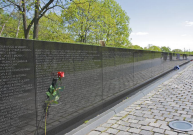 By Pastor Barb Recently I attended a seminar on “natural” or “green” burial. I’d been hearing about this growing trend for a while, and wanted details. The speaker reviewed the history of burial traditions and beliefs, some of which focused on the need to bury the body intact, in anticipation of “the resurrection of the body.” This was futile, I thought. Try as we will, there is no reasonable way to preserve a body intact after death. I recall visiting Lenin’s tomb when I was in Moscow many years ago. His body was laid out under glass for viewing, and preserved by coating him with layers of wax from time to time. But it was clear that most of what we were seeing was not Lenin, but just the wax—the superficial evidence of a wish to hold on to something that was lost. In that case, the Soviets made an icon out of one of their founders, by venerating his body. The casket of royalty or a church leader that bears the likeness of its occupant on its lid has a similar purpose. We can visit them and imagine we are in the presence of those great people. It’s a little like relics. Tiny remnants of bones thought to belong to an apostle draw pilgrims by the thousands. Or, perhaps it’s like the feeling we might have if we had met a Civil War veteran. We want to look into the eyes that have looked into the eyes of Lincoln. Keeping Grandma’s lace hanky or grandpa’s favorite pipe serves the same purpose. We find meaning in these things—in connecting across time and space to something we value, something good; something that’s been lost. In many places across the world, headstones have photographs of the deceased etched into their surfaces. If you’ve ever visited the Vietnam memorial in Washington DC (pictured below), you might know the power of having the names of those lost etched into that wall. People run their fingers over the indentations that form the letters, and feel connected to their loved ones. These efforts to stay connected are perfectly natural, and human. They help us in our grief, and ease our sense of loss. But they are limited, and finite. We might lose Grandma’s hanky or misplace Grandpa’s pipe. The eyes of the last Civil War veteran closed long ago. Then how do we stay connected, forever? As I listened to the seminar speaker describe “green” burial, I thought how well that fits with our theology. It returns us to the life cycle of the earth from which we came, with no chemicals, no materials that will not biodegrade, and no structures that will hinder the process. And, as we are given back to the earth we nurture new growth and life. There is another cycle of life within God’s Creation that is perpetual, beyond the body. I think of it each fall as we approach All Saints Sunday, which we will observe this year on November 3. Recently I heard this described in words so beautifully that I don’t need to paraphrase it. It is associated with the Jewish prayer service called Kaddish. I believe it’s what all our loved ones who have gone before would like to say to us if they could. As you seek ways to stay connected to those you’ve lost, I commend it to you. |
Archives
March 2020
Categories |
 RSS Feed
RSS Feed
